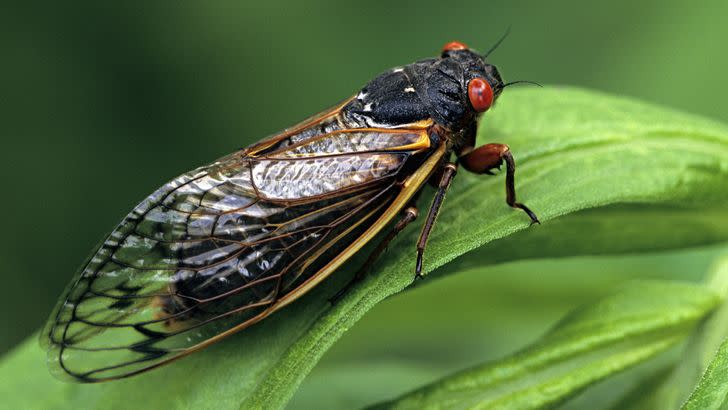Billions of Cicadas Are Coming: Are You Ready? What to Know About 2024’s Cicada Season

"Hearst Magazines and Yahoo may earn commission or revenue on some items through these links."
Two cicada broods are expected to emerge around the same time this year.
The “double brood” will bring billions of bugs with it.
The event is being called a “cicadapocalypse” and “cicada emergency.”
Cicadas, the loud bugs that look like oversized flies, are expected to have a banner year in 2024. While some species of these bugs come out of the ground every spring and summer, others stay burrowed for more than a decade, emerging in what’s known as a “brood”—and there’s a double brood coming this year.
You can expect to see plenty of these red-eyed bugs hanging out this spring and summer in what’s already been dubbed a “cicadapocalypse.”
But what, exactly, is going to happen when these critters emerge and how can you prepare now for when the cicadas come out? Here’s the deal.
Will there be a lot of cicadas in 2024?
Yup, there will be a lot of cicadas emerging in 2024. “Periodical cicada population densities can reach hundreds of thousands of cicadas per acre in areas with lots of trees,” says Jim Fredericks, Ph.D., a board-certified entomologist and senior vice president of public affairs at the National Pest Management Association.
This year, billions of cicadas are expected to dig themselves out of the ground in the form of two different broods that are resurfacing at once.
Those are led by Brood XIX, aka the Great Southern Brood, which is known as the largest periodical cicada brood and appears every 13 years, according to the University of Connecticut. But the other brood surfacing is Brood XIII, aka the Northern Illinois Brood, which emerges every 17 years, the University of Illinois Urbana-Champaign says.
This simultaneous appearance hasn’t happened since 1803 and won’t happen again until 2245, says Frank Meek, a technical services manager at Orkin. “These periodic broods are different from the cicadas that come out every year,” he adds.
Basically, expect to see periodical cicada broods on top of types that emerge each year. “Every year most of the United States sees the emergence of one or more of 12 different species of annual cicadas,” says Jody Gangloff-Kaufmann, Ph.D., an entomologist at Cornell University.
When do cicadas come out in 2024?
There’s no set date when the cicadas will all emerge from the ground. However, they are expected to surface sometime this spring, says George Hamilton, a researcher and extension specialist in pest management at Rutgers University. Exactly when they’ll come out “depends on the weather and temperature—the soil has to reach a certain temperature for them come out,” he says.
“They’re likely to come out after a warm rain,” Meek says. “The emergence takes about 4-6 weeks, typically between late May through June.” But you might see some cicadas sooner than that. “Since this winter has been warmer than usual, their emergence may be earlier,” Gangloff-Kaufmann says.
Where will cicadas come out?
The University of Connecticut has detailed information on where each of the broods are expected to emerge. Those spots include:
Alabama,
Arkansas
Georgia
Illinois
Indiana
Kentucky
Louisiana
Maryland
Missouri
Mississippi
North Carolina
Oklahoma
South Carolina
Tennessee
Virginia
People in Illinois and Indiana should mentally prepare now: Both broods are expected to come together there, Meek says. “For the most part, broods don’t overlap, but the edges of the Brood XIX and Brood XIII periodical cicadas ranges may have twice the amount of cicadas compared to a normal emergence event,” Fredericks says.
What happens once cicadas come out?
It depends on where you’re located—some areas will see more cicadas than others. These bugs are large and slow-moving, and they tend to hang out just about everywhere. They also leave their old exoskeletons, called exuvia, laying around, says Chad Gore, Ph.D., entomologist and market technical director for Terminix. “These exuviae are often found attached to trees and fences or scattered on the ground,” he says.
The big focus of these bugs is mating, the University of Illinois Urbana-Champaign says. Male cicadas will start “singing” (which sounds like a loud buzz) four or five days after they emerge to try to attract females. “They make a lot of noise,” Hamilton points out.
After they mate, the females will lay 500 to 600 eggs on the small branches of woody plants, Hamilton says. The adult cicadas will hang out for about a month before dying off, with their carcasses building up under trees, the University of Illinois Urbana-Champaign says.
Eggs will hatch six to 10 weeks after they’re laid. The cicada nymphs will then drop to the ground and start feeding on grass roots, before digging eight to 12 inches into the soil. They’ll hang out there before emerging in another 13 or 17 years.
“The only hazard comes from cicada killer wasps, which attack cicadas and place them in subterranean tunnels the wasp create” Meek says. “They can sting humans if they’re pestered, so people living in active areas should watch where they step.”
How to prepare for the cicadapocalypse
Cicadas don’t bite or sting, Fredericks says, but they can mess with your plants, especially if they’re young or have new growths. Female cicadas use an appendage called an ovipositor to cut slits in twigs to lay their eggs, and they may suck plant fluid from young twigs, Gore says.
That said, you don’t need to stress about your trees and bushes if they’re mature. “Cicadas lay eggs into the soft tissues of new growth on trees—up high—which causes the tips of the branches to die and fall to the ground,” Gangloff-Kaufmann says. “This is natural, not harmful, and probably nature’s pruning service. Most plants are adapted to the activity of native insects.”
Also, there’s no need to treat cicadas with pesticides, Gore says. “Treatment is usually unnecessary since cicadas’ lives are short-lived,” he explains. “They’ll naturally go away in about five to six weeks.”
Cicadas could also accidentally pierce your skin with their mouthparts if you handle them, so you don’t want to go picking up cicadas if they land someplace you don’t want them to. Instead, it’s usually recommended that you use a hose to remove them outdoor places where you’d rather they not be.
Finally, Fredericks stresses that these bugs can get loud. “Cicadas are known as the loudest insect in the U.S., as their ‘singing’ can be heard for up to a half mile away,” he says. That’s why Hamilton recommends investing in ear plugs if you live in an area where a lot of cicadas are expected to emerge.
What do you need for cicada season?
If you’re nervous about having cicadas around your home, consider using these products to help:
Foiimio 75-Foot Expandable Garden Hose
While you don't want to handle cicadas, a garden hose with a good sprayer can help remove them from your outdoor spaces and plants.

Foiimio 75-Foot Expandable Garden Hose
amazon.com
$49.99
AmazonEvoio 4 Pack Fruit Protection Bags
Cicadas won't damage established trees, but they can damage young plants and trees with new growths. Putting a mesh bag over your vulnerable plants when the cicadas start to emerge can help protect them.

Evoio 4 Pack Fruit Protection Bags
amazon.com
$19.99
AmazonMack's Ultra Soft Foam Earplugs, 30 Pair
Cicadas can get loud, and they don't care if you're trying to work or sleep. Mack's earplugs have a noise reduction rating of up to 33 decibels, and feel soft in your ears.

Mack's Ultra Soft Foam Earplugs, 30 Pair
amazon.com
$11.99
AmazonYou Might Also Like

